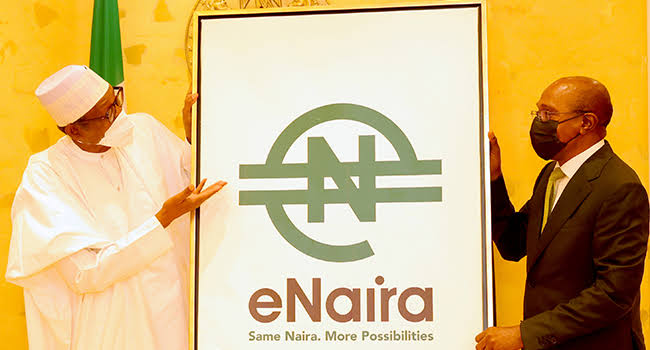Only one in 200 Nigerians are believed to utilise the eNaira one year after Nigeria adopted it, according to surveys.
Low uptake, poor usability, and the issues with the currency Naira have rendered the eNaira unattractive.
President Muhammadu Buhari introduced the Nigerian Central Bank’s digital currency, the eNaira, on October 25, 2021, with the tagline “same Naira, more possibilities.” The country has had trouble embracing the digital money after it has been in use for a year. But it appears that people are quickly embracing Bitcoin and other cryptocurrencies.
Nigeria, like many other African nations, immediately embraced the Bitcoin movement. People hurried to dip their toes into the new world of digital cash.
The struggling nation’s currency, Naira, was introduced in a digital format as the government’s response to the rapid cryptocurrencies’ adoption rate. It would appear that the goal was to satisfy Nigerians’ hunger for web 3.0 technology by providing them with a “secure” digital currency. Since the eNaira and fiat Naira are interchangeable, the motto “same Naira, more possibilities” captures more than just that. It was possibly the first indication that the virtual money would have trouble.
With the backing of the Nigerian Securities Exchange Commission and the International Monetary Fund, the Central Bank of Nigeria ordered banks to terminate functioning accounts of bitcoin service providers.
Some see the eNaira as a Nigerian government effort to first restrict easy access to cryptocurrencies and subsequently provide a free-to-use digital currency for Nigerians. There hasn’t been much positive news for Africa’s first Central Bank Digital Currency after more than a year in use.
The Nigerian government also wanted to increase financial inclusion for Nigerians who were previously unbanked by using the eNaira. Other users of digital currency believed that this was a noble as well as a realistic objective.
The eNaira has been severely hindered by low adoption, poor utility, and the issues with the fiat Naira, which has resulted in overall startlingly low adoption rates as well as extremely low confidence in the push into digital money.
Only one in 200 Nigerians, according to surveys, use the eNaira. By many, if not all measures, that is abysmally low. Nigerians continue to welcome other cryptocurrencies, much more so. Since the country’s cryptocurrency use was banned in February 2021 and the eNaira was introduced in October 2021, adoption of Bitcoin and other cryptocurrencies has actually surged.
Experts estimate that Nigerian peer-to-peer Bitcoin transactions totalled US$34.4 million during the second quarter of 2022. Nigeria’s Q2 total, however, is higher than the aggregate GDP of the next top 5 African nations (South Africa, USD15.2 million, Kenya, USD7.8 million, Ghana, USD640,000, and Tanzania, USD600, 000). This is taking place in the face of an actual cryptocurrency ban.
According to statista.com, Nigeria’s internet penetration rate for 2022 is 38.73%, and the nation is not anticipated to cross 50% in the next five years. Nigeria has one of the highest internet access costs in the world. The limited utility of the eNaira can be somewhat explained by the fact that you need the internet to use it.
There isn’t really a long history of the fiat Naira being a popular currency. When compared to other major currencies, particularly the US dollar, the currency has regularly and continually lost value year after year. Since the fiat Naira has not been inflation-proof, several cryptocurrencies, like Bitcoin, are attractive.
Unfortunately, the Naira’s issues have not been resolved by branding it as a Central Bank Digital Currency. Exactly for this reason, people have little faith in digital currencies. Therefore, the “additional possibilities” don’t truly exist; the Naira is still the same.
The distinction between a cryptocurrency, digital currency, and a CBDC is, at best, intellectual and largely nonexistent to the typical user. The CBN’s strict position on cryptocurrencies may have unintentionally contributed to some of the issues the eNaira is facing.
There are significant concerns with the eNaira CBDC implementation as well. According to certain perspectives, the introduction of the eNaira was a clear example of “putting it out there and finding a use for it later.” As a result, the digital currency has been stagnant. The aforementioned internet factors apply even though Android and iOS apps are available for accessing the eNaira wallet.
By August 2022, the eNaira app had 840,000 downloads. There were in fact 270, 000 active wallets, 252, 000 of which were consumer wallets and a concerning 17, 000 merchant wallets. With an anticipated population of 211.4 million individuals in 2021, this will be Africa’s most populous country. According to this, the eNaira’s adoption rate is roughly 0.12%.
It is difficult to envision a change in the fortunes of the eNaira without the support of banks and the industry at large. Suggestions such as paying part of civil service salaries in eNaira seem just as ill-fated as plans to preserve the value of the fiat Naira by blocking the transfer of funds outside the country.
Perhaps the lesson from the eNaira as a CBDC for other countries watching is that citizens may not want the same currency, even with more possibilities.


